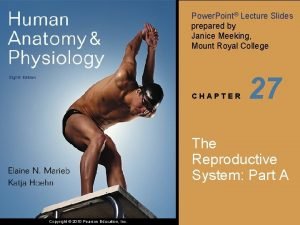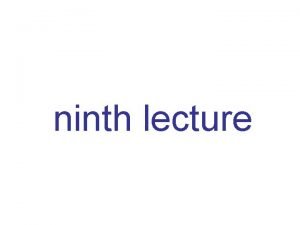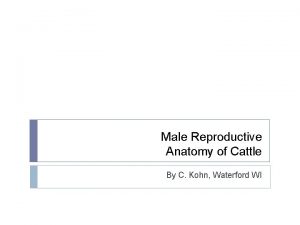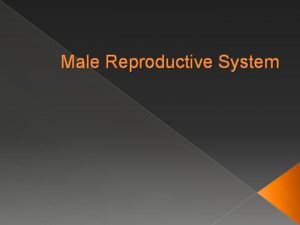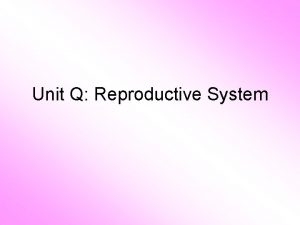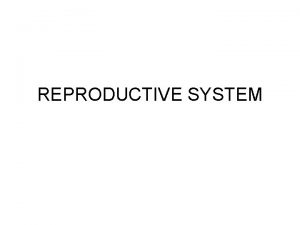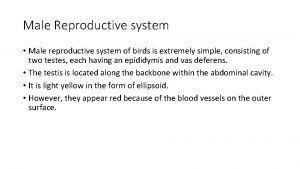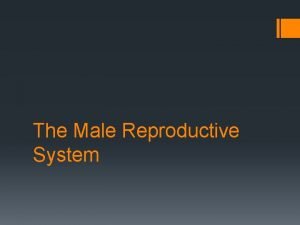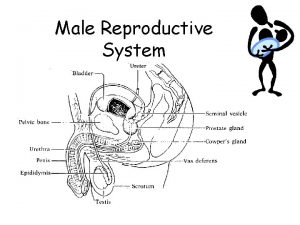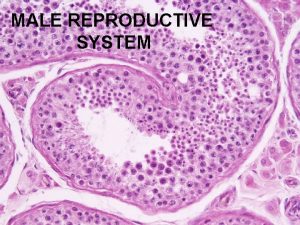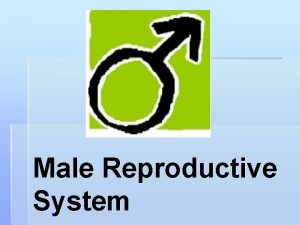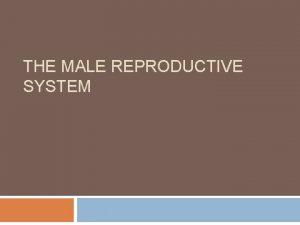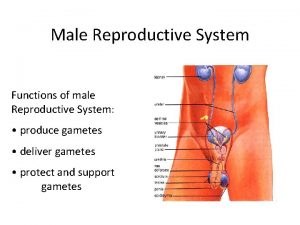Disorders of the Testes Male Reproductive System Dr




















- Slides: 20

Disorders of the Testes & Male Reproductive System Dr Surojit Das, Ph. D Assistant Professor Vidyasagar University

Normal Male Pubertal Development

Tanner stages/scale The Tanner scale (also known as the Tanner stages) is a scale of physical development in children, adolescents and adults. The scale defines physical measurements of development based on external primary and secondary sex characteristics, such as the size of the breasts, genitals, testicular volume and development of pubic hair. This scale was first identified by James Tanner, a British pediatrician, and thus bears his name. Due to natural variation, individuals pass through the Tanner stages at different rates, depending in particular on the timing of puberty. In HIV treatment, the Tanner scale is used to determine which treatment regimen to follow (adult, adolescent or paediatric).

Sexual maturity Rating (Tanner staging) in Adolescents

Regulation of Testicular Function

Feedback Regulation of the Hypothalamic-Pituitary-Testicular Axis in Adult Man

Gn. RH, LH, FSH Gonadotropin releasing hormone (Gn. RH) Secreted by hypothalamus into hypothalamo-hypophyseal portal system Increases at puberty, less sensitivity to testosterone feedback Pulsatile release ~90 min pulsatile LH & FSH release Luteinizing hormone (LH) From anterior pituitary, stimulated by Gn. RH, inhibited by testosterone Acts on Leydig cells of testis testosterone release Follicle stimulating hormone (FSH) From anterior pituitary, stimulated by Gn. RH, inhibited by inhibin Acts with testosterone on Sertoli cells to promote spermatogenesis Note: LH & FSH are produced by the same anterior pituitary cell. 7

Testosterone Source synthesized & released by Leydig (interstitial) cells of testis release stimulated by LH Actions inhibits release of Gn. RH & LH (not FSH) stimulates spermatogenesis (in conjunction with FSH) stimulates differentiation of male genitalia (in utero) stimulates development of male 2 sexual characteristics at puberty growth & development of internal/external genitalia bone growth and epiphyseal plate closure, muscle development axillary, pubic, body hair, male pattern baldness fat distribution, laryngeal growth, sebaceous glands behavioral effects, libido, aggression Mechanism: steroid, androgen binding protein, transcription, translation 8


The Leydig Cell: Androgen Synthesis

• Circulating testosterone is bound to two plasma proteins: albumin & sex hormone-binding globulin (SHBG). • Acc. to the “free hormone” hypothesis, only the unbound fraction is biologically active. • Albumin-bound hormone dissociates readily in the capillaries & may be bio-available. • Testosterone is metabolized predominantly in the liver, although some degradation occurs in the peripheral tissues, particularly the prostate & skin.

Clinical & Laboratory Evaluation of Male Reproductive Function

Gonadotropin (LH, FSH) & Inhibin Measurements

Testosterone Assays



Abnormal Spermatogenesis & Male Fertility

Effect of temperature on spermatogenesis Increasing the temp. of the testes can prevent spermatogenesis by causing degeneration of most of the cells of seminiferous tubules. Cryptorchidism Failure of testes to descend from the abdomen into the scrotum at or near the time of birth of a fetus Effect of sperm count on fertility Semen ejaculate: 3. 5 ml Sperm count: 120 million/ml (35 -200 million/ml) Ave. total sperm per ejaculate: 400 million Infertility: <35 million/ml sperm 18

Effect of sperm morphology & motility on fertility <<<<<<Abnormal>>>>> Normal 19

Abnormalities of Male Sexual Function Prostate gland & its abnormalities Benign prostatic fibroadenoma: This hypertrophy is caused by abnormal overgrowth of prostate tissue but not by testosterone in many older men & cause urinary obstruction. Prostatic cancer: Stimulates by testosterone & are inhibited by removal of both testes or by administration of estrogens. Hypogonadism: Primary testicular failure originates form a problem in the testicles or in the hypothalamus or the pituitary gland (parts of the brain that signal the testicles to produce testosterone) [Fig. 80. 11]. Hypergonadism: Interstitial Leydig cell tumors develop in the testes producing higher amounts of testosterone. 20
 Chapter 17 reproductive system diseases and disorders
Chapter 17 reproductive system diseases and disorders Function of the vagina
Function of the vagina Male genital hygiene
Male genital hygiene Frog testis labeled
Frog testis labeled Anatomy of the reproductive system exercise 42
Anatomy of the reproductive system exercise 42 Lutalphase
Lutalphase Broad ligament
Broad ligament Female and male reproductive system
Female and male reproductive system Figure of male reproductive system
Figure of male reproductive system Reproductive physiology
Reproductive physiology Male reproductive system in plants
Male reproductive system in plants Art-labeling activity: the male reproductive system, part 1
Art-labeling activity: the male reproductive system, part 1 Male reproductive system information
Male reproductive system information Reproductive organ
Reproductive organ Functions of testis
Functions of testis Prostate glands
Prostate glands Examples of asexual reproduction
Examples of asexual reproduction Function of male reproductive system
Function of male reproductive system Anatomy of fish reproductive system
Anatomy of fish reproductive system Reproduction in pila
Reproduction in pila Mammary papilla pig
Mammary papilla pig











